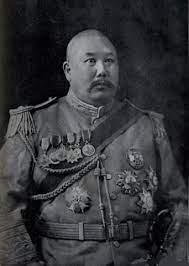Ma Fu-hsiang (1876-19 August 1932), Chinese Muslim leader who ruled the district that later became Ninghsia (1913-20) and the Suiyuan special district (1921-24). He was appointed co-director with Feng Yü-hsiang of northwestern border defense in 1924, but he left Feng's service in 1929. He then served the National Government as governor of Anhwei and chairman of the Mongolian and Tibetan Affairs Commission.
Hanchiachi, Taoho hsien, Kansu, was the birthplace of Ma Fu-hsiang. He belonged to the only Muslim sect in the region that had not taken part in the Muslim Rebellion of 1862-77, and his father reportedly had come to know Tso Tsung-t'ang (ECCP,'lI, 762-67) after Tso had established headquarters at Lanchow in 1872. The youngest of four brothers, Ma was trained for a military career from early childhood. He greatly admired his elder brother Ma Fu-lu and emulated him in mobilizing volunteer troops to aid the regular -army at the time of the 1896 uprisings in the Hsunho region.
After passing the provincial military examinations in 1897, Ma Fu-hsiang joined the Kansu forces of Tung Fu-hsiang, serving in a cavalry company commanded by Ma Fu-lu. Tung's force soon moved to Chihli (Hopei) and became one of the five constituent armies of the Military Defense Army, under the over-all command of Jung-lu (ECCP, I, 405-9; . During the Boxer Uprising of 1900 Tung's army moved to Nanyuan and then to Peking, where it fought foreign troops, attacked legations, and engaged in looting. The unit commanded by Ma Fu-lu participated in the fighting at Huangts'un, Liulin, and Yangts'un. After Ma Fu-lu was killed at Peking, Ma Fu-hsiang assumed command of the cavalry unit. When the emperor and the empress dowager fled the capital, Ma Fu-hsiang accompanied them to Sian as a member of their military escort. He then held a variety of commands at Sining, in the Kokonor district, and at Barkol. About 1910, having become a brigade commander, he was assigned to garrison duties at Lanchow. At the time of the 1911 revolution, Ma Fuhsiang collaborated with other provincial officials in announcing the neutrality of Kansu. In 1912 he accepted appointments as acting chief administrative officer of the Kokonor region and as guards commander of the Altai district. When Outer Mongolia declared its independence, the Mongols of the Ordos region became restless; and in September 1913 Ma was appointed to the Yinch'uan garrison as deputy military commissioner of Inner Mongolia and Kansu. He soon captured the Dalat Banner leader Wang-te-ni-ma at Paotow, and he was rewarded with promotion to the rank of lieutenant general and appointment as guards commander for the Yinch'uan region. Ma held command of the area that later became Ninghsia for seven years. Then, on 31 December 1920, the Peking government appointed him military governor of the special district of Suiyuan. He governed the district from the beginning of 1921 to the end of 1924. After Feng Yü-hsiang (q.v.) effected a coup at Peking in November 1 924, Ma was replaced as governor of Suiyuan by Li Ming-chung and was appointed co-director of northwestern border defense, the other director being Feng himself.
Little is known about Ma Fu-hsiang's activities in the 1925-27 period except that he continued to serve Feng Yü-hsiang. In 1928 he received membership in the Peiping and Kaifeng branches of the Political Council, in the Military Affairs Commission, and in the Kansu provincial government. When Feng Yü-hsiang turned against the National Government in 1929, Ma parted company with Feng and induced his son Ma Hung-k'uei (q.v.) to join with Han Fu-chü (q.v.) in defecting to the National Government side. Later in 1929, Ma Fu-hsiang became vice chairman of the Mongolian and Tibetan Affairs Commission and mayor of Tsingtao. In 1930 he succeeded Shih Yü-san as governor of Anhwei and became a member of the Central Executive Committee of the Kuomintang.
With the failure of the so-called enlarged conference movement (see Feng Yü-hsiang; Yen Hsi-shan) in 1930, Ma Fu-hsiang and Chang Chih-chiang q.v.) assumed control of the remnant Kuominchün forces and began to reorganize them as National Government troops. From mid- 1930 until late 1931 he served as chairman of the Mongolian and Tibetan Affairs Commission. During this period, he also worked to rearrange the power structure of Kansu {see Ma Hung-pin). He was made a member of the State Council in December 1931. A few months later, while visiting his son at the mountain resort of Chikungshan, Hupeh, he became seriously ill. He was put aboard a Peiping-bound express train in the hope that the staff of Peking Union Medical College could treat him successfully, but he died on the train at Liuliho, Hopei, on 19 August 1932. Ma Hsiang-po: see Ma Liang.

马福祥
字:云亭
马福样(1876—1932.8.19),回族首领,1913—20年曾统治宁夏,1921—24年统治绥远特区,1924年与冯玉祥同为西北边防使,1929脱离冯玉祥,后为国民政府效劳,担任过安徽省主席,蒙藏委员会委员长。
马福祥出生在甘肃洮河韩家集,他所属的回族,是该地唯一没有参加1862—1927年的回民起义的一支。据说左宗棠于1872年在兰州设署后,他父亲曾同左相识。马福祥在兄弟四人中居幼,早年即从军,钦佩长兄马福禄并加以仿效,1896生趁循河之乱,招募志愿人员支援正规部队。
1897年参加乡试中试,投奔董福祥甘军,在其兄马福禄的骑兵中服役,不久董福祥所部调往直隶,编为荣禄所统五支禁军之一,1900年义和团运动时,董福祥军调往南苑,旋即进入北京,与外国军队作战,袭击使馆,参与劫掠。马福禄率部在黄村、柳林、柳村作战。后在北京被杀,所率部队由马福祥接管。光绪、慈禧逃离京时,马福祥随从去西安。后任西宁、库库诺尔、巴里坤等地总兵。大约在1910年时,任巡防统领,驻扎兰州。
1911年革命时,马福祥与省内其他官员宣布甘肃中立,1912年任库库诺尔民政长,阿尔泰总兵。外蒙宣布独立时,鄂尔多斯蒙族发生骚动。1913年9月马福祥出任蒙甘总兵,驻扎银川,不久,在包头捕获达位特旗领袖王德呢玛,晋升为中将,就任银川护军使,控制了以后称为宁夏的这一地区达七年之久。1920年12月31日,北京政府任命他为绥远特区都统。他自1921年初起任职至1924年底。1924年11月,冯玉祥在北京实行兵变,马福祥调任,与冯同为西北边防督办,绥远都统由李鸣锺继任。
马福祥在1925—1927年间的活动不详,但仍在冯玉祥手下任职。1928年他担任北平,开封政治分会委员,军事委员会委员,甘肃省政府委员。1929年,冯玉祥反对国民政府,马福祥遂与冯玉祥分手,并指令其子马鸿逵与韩复榘联合投向国民政府。1929年底,马福祥任蒙藏委员会副委员长,青岛市长。1930年,继石友三出任安徽省主席,并成为国民党中央执行委员。
1930年,扩大会议运动失败后,马福祥和张之江收集国民军余部改编为国民政府的部队,1930年中至1931年底他出任蒙藏委员会委员长,同时又着手改组甘肃省政府。1931年12月,他成为国府委员。几个月后,他去探望在河南鸡公山休养的儿子,忽患重病,即由专车送往北京协和医院抢救,但在1932年8月19日,在行车途中,死于河北琉璃河车站。